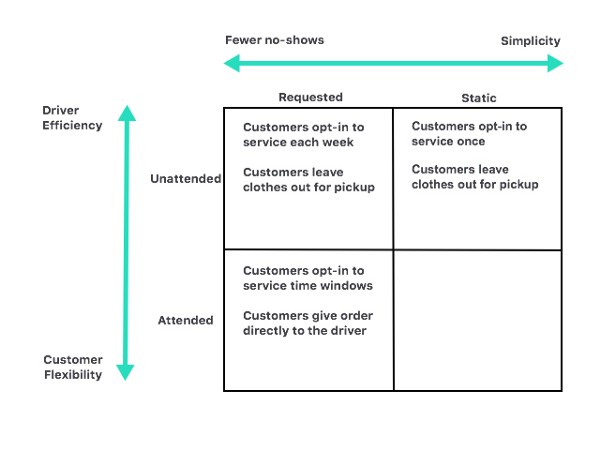Since founding Starchup, we have learned more than we ever thought possible about dry cleaning and laundry delivery. One concept that took us a while to nail down was the different ways cleaners schedule their delivery service.
We have found that delivery services tend to differ in two ways: (1) whether customers are present at pickup/delivery (attended vs. unattended) and (2) whether customers opt-in to or opt-out of each day’s route (static vs. requested).

Unattended Routes
Dry cleaners have long run Unattended delivery routes. Customers leave their clothes out on their porch, door, or garage to be picked up at some time during the scheduled route. Those clothes are then cleaned and returned to the customer’s home on the next day that the route runs.
The advantages of Unattended delivery are customer convenience and driver speed: customers can leave their clothes out in the morning and do not have to be home to meet the driver, and the driver does not wait for or interact with the customer at each stop. But this service type rarely works in urban areas, where access to multi-unit buildings and safety concerns with leaving clothes in public are barriers to service.
Static vs. By Request
The main variation in the way cleaners run unattended delivery service is whether they run Static Routes or accept By Request Orders (or both!).
The beauty of Static Routes is in their simplicity: Customers sign up to join a route, which runs on predetermined days, such as Monday & Thursday. The driver stops at every customer location on that route. If the customer needs service that week, the driver picks up their bags; if not, he or she continues on to the next stop.
The problem with simplicity is that customer’s needs are varied (and demanding). Many do not have service needs each week, and others may need service outside of the offered days. Indeed, drivers on most Static Routes that we encounter drive by 60–80% of customers on the route who do not have pickups, wasting time and gas.
To increase driver efficiency, many cleaners offer By Request (or Will Call) service, only stopping for that customer if he or she requests a pickup that week, greatly reducing customer no-shows. Advances in mobile and SMS technology have made placing an order more convenient for the customer than ever. Increased efficiency is literally at your fingertips.
Attended Delivery
Finally, cleaners and most of the “laundry apps” attacking the urban markets offer Attended delivery service. Customers place orders for pickup and delivery at specific times, usually choosing hour-long blocks. Because the driver arrives at a specified time, the customer does not need to leave their clothes in a public space if they have safety concerns. Instead, the driver knocks and takes the order directly from, and delivers to, the customer.
On Demand
The final service variation, which has caused much ado recently, especially in the Washio’s wake, is On Demand. This aims at maximizing convenience by having drivers on standby to enable customers to place orders at any time of the day.
As Washio discovered, the cost of On Demand convenience squeezes already tight profit margins into the negative, and unnecessarily: unlike rides and food, customers don’t need cleaning On Demand.
So what type of delivery service is right for your business? We will answer that question — as well as how technology improves each service type — in Part 2. And check out how Starchup's delivery management software helps you to make whichever type of delivery service you opt for more efficient.